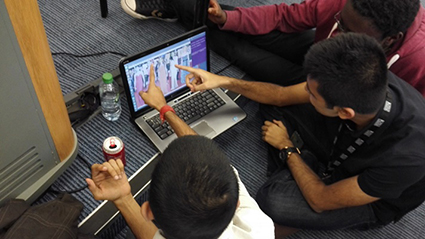Wheatstone Innovation Lab gets Robot Heads Turning
The Faculty of Natural & Mathematical Sciences’ newly opened Wheatstone Innovation Lab hosted one of its first makeathons, aimed at improving the head for the new King’s robot receptionist, Kinba. Teams of students and instructors gathered together in the Lab to tackle a number of upgrades for Kinba, such as face recognition and movement.
Speaking about the Lab, Matthew Howard from the Department of Informatics said:
“We have students from maths, physics and a lot of computer scientists. It is an open forum for any student from King's to come in and work on any project in an unstructured way. So it's not tied to any courses, coursework but it’s basically, you sign up and you get access to the equipment we have here. We have a 3-D printer, a milling machine that prints circuit boards, we provide lots of fun stuff like Raspberry Pi and Arduinos. It's a joint project between physics and informatics so they provide some physics toys like a super fancy microscope. The idea is that when you become a member you get to work on any side project you have in mind.”
There were four teams during this makeathon. Team 1 focussed in on creating a robot arm that could point people in the direction of their room. They also examined the possibility of engineering the arm to use a map to show people how to get to different places. This was the most visible project where multiple students worked with the arm, drilling holes, attaching motors and programming them to imitate arm movement.
Team 2 were concerned with the robot’s vision. They worked with photo recognition software and investigated the potential of using the King’s photograph database to teach the robot to recognize individual students and professors.

Team 2 testing the software's photo recognition capabilities.
Team 3 looked at social media integration for the robot and attempted to programme it to live tweet about events and answer questions. They also worked on another process that would to reply to a live twitter feed while doing other tasks. This involved finding the right chat bots (software for talking using artificial intelligence) that would be able to produce answers suitable for twitter. This part of the project also has the potential to improve the robot’s speech generation, possibly allowing Kinba to have face to face conversations with people in the future.
Finally, Team 4 concentrated on building the mouth for the robot using an LCD screen to make it more human-like and expressive in terms of emotion. They used different people to model for the project and recorded their mouths expressing various emotions to understand how lips behave, then they modelled the behaviour of the LCD lips to imitate it.
The makeathon wasn’t a competition, it was a collaboration where the reward is learning, teaching your classmates and seeing the finished robot’s head in situ in the reception of the Strand Campus of King’s College London. It was open to students at all levels and provided a fantastic introduction to robotics and programming for new students in the Faculty of Natural & Mathematical Sciences. One of the supervisors was extremely impressed saying:
"They're first-years that have barely had any training in coding so far, yet today they learned to program in C and import the instructions onto a circuit board that takes care of motors for the arm."
There will be a number of makeathons held in the Wheatstone Innovation Lab over the coming months, with work in the areas of clothing technology, such as electricity conducting threads, and flexible chips for muscle tension detection. King's students who want to be part of these can register here.